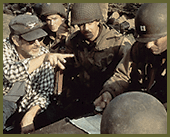Steven Spielberg answers AC’s questions about his cinematic battle plan for SAVING PRIVATE RYAN.
Over the past half-century, World War II has been one of cinema’s favorite subjects, spawning a genre that rivals the Western in sheer breadth. Countless films have been made about the granddaddy of all global conflicts, a roll call that runs the gamut of patriotic, action-oriented epics (Sands of Iwo Jima, Twelve O’Clock High, The Great Escape), searing documentaries (The Sorrow and the Pity, Shoah), biographical portraits of larger-than-life heroes (Patton, MacArthur) and villains (Hitler), romantic dramas (From Here to Eternity, Casablanca), spy thrillers (Saboteur, Eye of the Needle) revisionist satires (Catch-22), comedies (Mister Roberts) and even musicals (South Pacific).
Given the staggering number of pictures set during the "Good War," it would seem that a fresh perspective on this monumental event would require the attention of a truly gifted auteur with a unique sensibility. Enter Steven Spielberg, who was recently named the "most influential director of the 20th Century" by Time magazine. Spielberg demonstrated an affinity for the era with 1941, the Raiders of the Lost Ark trilogy and Empire of the Sun before stunning the world’s moviegoers with Schindler’s List, a masterful dramatization of the Holocaust. The filmmaker and studio mogul has returned to his favorite historical period with Saving Private Ryan, an intense, strikingly authentic epic which uses the bloody D-Day invasion as its backdrop.
Hollywood has rendered the pivotal Normandy battle before, most notably in the 1962 all-star CinemaScope spectacular The Longest Day (see Wrap Shot, page 120), which earned Oscars for both black-and-white cinematography (by the team of Jean Bourgoin, Walter Wottitz, Henri Persin and Pierre Levent) and special effects (Robert MacDonald and Jacques Maumont). But few filmmakers have demonstrated Spielberg’s skill with large-scale action and the mechanics of suspense, and the director maintains that his rendering of the Omaha Beach massacre is "as unflinching as Schindler’s List" in its depiction of wartime horrors.
Spielberg recently took time out of his busy schedule to answer AC’s questions about his latest celluloid adventure.
American Cinematographer: Why are you so drawn to the World War II era as a setting for your films?
Steven Spielberg: I think that World War II is the most significant event of the last 100 years; the fate of the Baby Boomers and even Generation X was linked to the outcome. Beyond that, I’ve just always been interested in World War II. My earliest films, which I made when I was about 14 years old, were combat pictures that were set both on the ground and in the air. For years now, I’ve been looking for the right World War II story to shoot, and when Robert Rodat wrote Saving Private Ryan, I found it.
On the surface, World War II is a classic conflict between good and evil, but this picture addresses some philosophical issues which aren’t quite so clear-cut. The soldiers who are sent out to rescue Private Ryan are conflicted and openly critical of their mission.
Spielberg: From an historical perspective, the Second World War seems pretty cut-and-dried, or black-and-white. But inside a war, and inside combat, it’s technically chaotic and personally very contradictory. When we look back from the standpoint of history, we can say, ’Oh yeah, World War II clearly set the good and bad apart from one another.’ But inside combat, the issue is never that clear. To the soldiers fighting the war, it can be very confusing.
[ continued on page 2 ]
